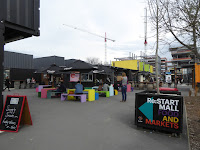 |
| Christchurch |
Visiting
Christchurch felt slightly strange, as the city is still showing the scars of
the devastating earthquake that hit it in 2011.
Driving into town, there are building works everywhere, as they work to rebuild the city. It felt a little odd to park in a clearing where you know that a building once stood; the rubble on the ground and a small section of graffiti covered wall are all that remain of it now.
 |
| Christchurch |
Driving into town, there are building works everywhere, as they work to rebuild the city. It felt a little odd to park in a clearing where you know that a building once stood; the rubble on the ground and a small section of graffiti covered wall are all that remain of it now.
 |
| Christchurch |
 |
| Old Cathedral, Christchurch |
The earthquake that hit the city at 12:51 on 22 February was an aftershock from September and only 6.3 on the richter scale, so could have passed by with only limited damage, but for the fact that it hit a shallower faultline and for effects of the liquefaction.
 |
| Christchurch |
The fact that this quake was less deep, only around 5km below the surface, means that the ground motion was around four times faster than previously, so caused far greater damage.
That motion also caused the liquefaction, which is basically where the waterlogged layers of silt and sand below the ground's surface are shaken so badly that they turn into liquid. That sludge moves, causing foundations to collapse. Where there are cracks in the ground, the sludge rises up and, together with the sewage from the inevitable broken pipes, floods the area and homes. The ground in some places becomes like quicksand.
 |
| Christchurch |
Around the city, you can still see the notes left on buildings by the search and rescue teams to record that they had been cleared.
 |
| Quake City, Christchurch |
 |
| Christchurch |
Whilst obviously moving, it isn’t overly graphic or gloomy, and is done in a very tasteful way. It does, however, give you an excellent insight into what it was like to be there. In our opinion, it was well worth the time spent watching.
 |
| Snapa Crapa, Christchurch |
 |
| RE:START, Christchurch |
One thing that we noticed around town, was the ever present sight of shipping containers. If there is a shortage of them anywhere else, you know why – they’re all here.
 |
| Re:START, Christchurch |
They are used as offices on the building sites, they are acting as supports for the facades of buildings where the rest of the structure has been demolished, and most interestingly, they have been used to create Re:START, a temporary shopping and food area.
 |
| Cardboard Cathedral, Christchurch |
The Cardboard Cathedral was intended as an interim solution, although having proved to be so popular, it is now expected that it will be used as the local church once the old cathedral is finished. It is, as the name suggests, made largely from cardboard. There are obviously some other materials used – more shipping containers for one thing – but the inside is definitely cardboard. It looks very impressive.
From outside, you can see that there is a definite twist in the outline of the building. This isn’t the cardboard collapsing, it is part of the design by Shiguru Ban.
 |
| Cardboard Cathedral, Christchurch |
 |
| Cardboard Cathedral, Christchurch |
 |
| 185 Empty White Chairs, Christchurch |
Near to the cathedral, is the most poignant reminder of the earthquake. It is a simple idea – 185 white-painted chairs, of varying sizes and types. These empty seats, all looking towards the cardboard cathedral, provide a very effective memorial to those who died.
No comments:
Post a Comment
We like to hear from you too, so please leave us a message here. We are also happy to answer any questions if we can help. Comments are moderated so will not appear straight away and there could be some delay in replying if we are travelling.